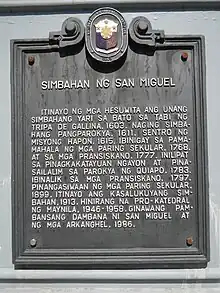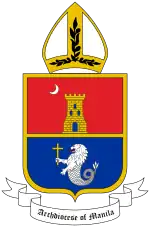| San Miguel Church | |
|---|---|
| National Shrine of Saint Michael and the Archangels | |
 Church facade in 2023 | |
| 14°35′31″N 120°59′30″E / 14.59194°N 120.99167°E | |
| Location | J.P. Laurel cor. Gen. Solano Streets, San Miguel, Manila |
| Country | Philippines |
| Denomination | Catholic |
| History | |
| Status | National Shrine |
| Founded | 1603 |
| Dedication | Saint Michael and the Seven Archangels |
| Architecture | |
| Functional status | Active |
| Architectural type | Church building |
| Style | European Baroque |
| Administration | |
| Archdiocese | Manila |
| Deanery | Jose de Trozo[1] |
| Parish | Saint Michael and the Archangels |
| Clergy | |
| Rector | Rev. Msgr. Mario D. Enriquez[2] |
The Royal Parish and National Shrine of Saint Michael and the Archangels (Spanish: Parroquia Real y Santuario Nacional de San Miguel y los Arcángeles), also known as San Miguel Church, is a Roman Catholic church of the Latin Rite dedicated to the archangels, namely, Saint Michael, Saint Gabriel, Saint Raphael .[3]
Its current location on the corner of Jose Laurel Street and General Solano Street in the San Miguel district was once the site of La Fábrica de Cerveza de San Miguel (now San Miguel Brewery).[4]
The shrine is also known as Malacañang Church as it is within the Malacañang Palace complex, the official residence of the president of the Republic of the Philippines.[3] Presidents that have heard Mass at the shrine include Carlos P. García, Gloria Macapagal Arroyo, and Fidel V. Ramos (who was Protestant).[3]
San Miguel Church has around 1,500 regular parishioners, some of whom are descended from old, rich families in the district.[3] It is also notably the only Catholic church in the country where priests (instead of bishops) have canonical dispensation to administer the Sacrament of Confirmation twice a week.[3]
History

San Miguel Church was first built in stone in 1603 by the Jesuits in Paco, Manila (formerly known as Dilao). In the 17th and early 18th centuries, there was an increase in the number of Japanese expatriates in that area, where they established a community.[5] In 1611, the Jesuits and Filipino Catholics accommodated the Japanese Christians who were persecuted by the Tokugawa Shogunate.[6] It was Blessed Dom Justo Takayama (高山右近), a daimyō or feudal lord, who led a group of approximately 300 Japanese Christians to the Philippines in 1614. According to some sources, the parish was named after Saint Michael, because most of the Japanese who arrived were of the samurai or warrior class.[7]
The church was damaged in the 1645 Luzon earthquake, and during the British occupation of Manila that was part of the Seven Years' War. The church was rebuilt in 1913 on its present site through the generous assistance of Doña Margarita Róxas de Ayala.[5]
The church served as the pro-cathedral of the Archdiocese of Manila while Manila Cathedral was being rebuilt from 1946 to 1958 following the city's destruction in World War II. It was elevated to the rank of a national shrine in 1986.[4][6] The church follows European Baroque architecture and features symmetrical bell towers.
Notable events

On May 1, 1954, Ilocos Norte representative and later president Ferdinand E. Marcos married beauty queen Imelda Romuáldez in the shrine (at the time still the pro-cathedral). Their wedding, which followed almost two weeks of courtship, was tagged as the Wedding of the Year, with President Ramon Magsaysay standing as principal sponsor.[8] Interestingly, Imelda's parents Vicente Orestes Romualdez & Remedios Trinidad were also wedded in the church (albeit at dawn, at the insistence of the groom's mother) in 1928, while her father's first wife Juanita Acereda (died 1926) is also interred in the church.[9]
Archbishop Gabriel M. Reyes, the archdiocese's first Filipino ordinary who served from 1949 to 1952, was initially buried in the shrine before his remains were transferred to the crypt of Manila Cathedral.[3] Also buried in the church are the remains of Don Domingo Róxas, patriarch of the Zóbel-de Ayala-Róxas-Soriano clans.[5]
Gallery
 Northern flank of the church, with its façade and twin belfries to the right
Northern flank of the church, with its façade and twin belfries to the right Statue of Saint Michael fighting the Devil, depicted as a dragon, in the parvise of the church
Statue of Saint Michael fighting the Devil, depicted as a dragon, in the parvise of the church One of the church bell towers
One of the church bell towers The main retablo
The main retablo Churchyard cemetery
Churchyard cemetery
References
- ↑ "Vicariate of Jose de Trozo". Roman Catholic Archdiocese of Manila. Retrieved March 4, 2021.
- ↑ "Clergy of Manila". Archdiocese of Manila. Retrieved May 22, 2023.
- 1 2 3 4 5 6 Macas, Trisha (October 6, 2014). "A Glimpse of the Forgotten National Shrine of St. Michael and the Archangels". GMA News Online. GMA Network News. Retrieved October 26, 2014.
- 1 2 Sebastian, Ina (October 18, 2014). "Manila: Back to the Past Touring Malacañang Palace, San Miguel Neighborhood". Rappler. Retrieved October 26, 2014.
- 1 2 3 de Jesús, Joaquín Carlos U. (April 26, 2013). "San Miguel de Manila: Arrabal de una abadía, buenas familias y cerveza". Kamusta Magazine. Archived from the original on June 1, 2013. Retrieved October 26, 2014.
- 1 2 "Churches to Visit in QC, Manila". Inquirer.net. March 27, 2013. Retrieved February 12, 2022.
- ↑ Arnaldo (February 17, 2014). "The Japanese of Old Manila". Retrieved February 12, 2022.
- ↑ "Today in Philippine History, May 1, 1954, Ferdinand Marcos and Imelda Romualdez were married". Kahimyang.info. February 16, 2013. Archived from the original on May 4, 2014. Retrieved October 26, 2014.
- ↑ Pedrosa, Carmen Navarro (1969). The Untold Story of Imelda Marcos. Tandem Publishing Company. ASIN B004X1NGV2.
External links
 Media related to San Miguel Church, Manila at Wikimedia Commons
Media related to San Miguel Church, Manila at Wikimedia Commons
